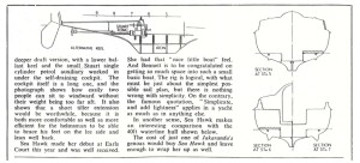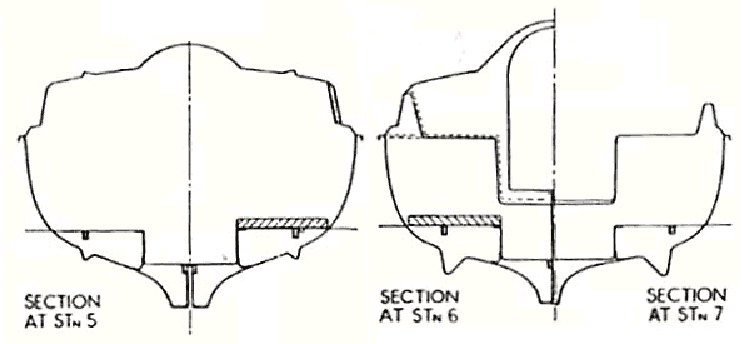Page updated: 9 November 2011
 Yachting World
Yachting World


This one and a third page spread from Yachting World caused confusion when it was first presented on the site. Then, it was understood to date from the time of the Pyefleet Boat Sales re-launch. Now it is recognised as coming from the June 1971 issue of the magazine. It includes a full version of the photograph used on the front cover the 1970 Reecraft brochure.
The various parts of the article have been enlarged in the sections below so the contents can be read.
 Main Text,
Dimensions and Photograph
Main Text,
Dimensions and Photograph
The text of the article is combined here into a single column. For dedicated SeaHawk fans there won't be much to argue with in the main text of the article. Only the last two sentences, which allude to another large yacht reviewed in the same spread, will leave you wondering what you've missed.

The exact dimensions of a SeaHawk, and probably most boats, always seem to be a point of issue. Here, leaving aside the issue of how long the boat actually is, it seems that the metric equivalent of almost all the figures have been miscalculated.
The metric figures presented here work out at around: LOA = 17'9", LWL = 15'8", Beam = 7'1", Draft = 1'7"/3'2". Then again, leaving aside the conversion calculations, the imperial LWL figure is shown here as 14'7", when the text of the article refers to 14.5', so there's another inch difference.
As intriguing is the sail area figure. Unsurprisingly, this is not the same as the area claimed in the brochures. However, there was always a debate about the accuracy of those dimensions as recorded on the Sails page.

As mentioned above, the photograph is pure Reedcraft, a full version of that used on the front cover the 1970 Reecraft brochure. You can see the original mainsheet arrangement, the strip of wood that forms the threshold in the port cockpit locker, the jib sheet cleats and the black anodised mast, not to mention the low sail number! However, the lack of pulpit and cockpit guard rails is unusual on a Reedcaft boat.
 Sail Plan
Sail Plan
One reason why the article was assumed to be of 2000 vintage when first sent to the site was because of the sail plan diagram. The sail emblem on the diagram is the one used by Pyefleet, as seen on Isolde, and not the hawk's head emblem used on all Reedcraft and Moore's built boats except, perhaps, boats exported to the US. That is said because the owner of Puffin, reports, his sails as showing "H 245".
Further evidence supporting a 2000 date was that the bottom batten in the main, is shown horizontal, when boats with sail numbers earlier than about #370 had the batten set at right angles to the leech, rather than parallel with the boom.
However, to counter that, the sail plan shows the headsail with the raised tack of Reedcraft and Moore's boats, whereas all photographs of Mistral-built boats show no strop to lift the the tack off the deck.

 Hull Plan and Profile
Hull Plan and Profile
Here, the evidence that these are early drawings comes from the elevation, where the distinctive wooden plate of the traditional two-berth design can be seen, inside the cabin under the base of the mast. Owners of Mistral-built boats all report the same four-berth layout, of all the boats built by Moore. In addition, these drawings show the keel rising into the cabin not the cockpit as it should do for a boat built by Mistral Craft.

 Fixed Keel
Fixed Keel
Again, this fixed keel diagram is classic 1970s, but not known on a SeaHawk. In fact, this design has only been known to have been available on the sister-design, the Señorita.
This diagram is also interesting as it shows a variation on the
standard SeaHawk inboard engine installation. With no drop
keel the area normally used to house the raised tip of the keel
under the cabin threshold is now available to house the engine. In
this diagram, the rare Stuart Turner.1.5hp engine, is set far
further forward than in drop keel boats, even enabling the starting
handle to be accessed from inside the cabin. Currently, we know of
no example of either a SeaHawk or Señorita that was built to this
design. 
 Hull Sections
Hull Sections
With so much to remark about in the rest of this article, it is, perhaps, surprising that the diagrams showing sections through the hull are of a standard drop keel boat.

